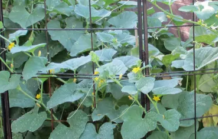https://hnr.k-state.edu/extension/info-center/newsletters/index.html
Blog Post: http://www.ksuhortnewsletter.org
Video of the Week: Composting: Making Black Gold
https://kansashealthyyards.org/all-videos/video/composting-making-black-gold
REMINDERS
• Divide iris if needed.
• Do not fertilize the warm-season turfgrasses, buffalograss, zoysiagras and bermudagrass, past August 15. Doing so may increase the chances for winter damage.
• Check mulch layers and add additional material if needed.
VEGETABLES
Still Time for a Salad Garden
Though we’re very much still experiencing the heat of summer it’s time to make plans for fall gardening. Choose crops that tolerate the weather as it turns cooler, but also the warm soil at planting. Cool season vegetables can be started from mid-August through early September. Some leafy greens that tolerate these conditions include: green and red leaf lettuce, kale, spinach, mustard, bok choy and endive. Radishes, beets and carrots are also good fall crops that can be tossed into a salad.
Prior to planting, turn the soil and incorporate a balanced fertilizer to replenish the garden from the previous crop. (Cynthia Domenghini)
FRUIT
When Are Apples Ready to Pick?
Apples mature over a long period of time depending on variety. Some varieties such as Lodi can mature in July and others as late as October or even November. Here are some guides to help you decide when to pick your apples.
Days from bloom: The number of days from bloom is a reliable guide for general maturity time, but weather conditions will have some influence. Some kinds of apples and approximate days from bloom to maturity are Jonathan, 135, Delicious, 145, Golden Delicious, 145, and Winesap,155 days.
Flesh color: As apples mature and starches change to sugars, the flesh changes from very light green to white. When you cut a thin slice and hold it up to the light you can see the difference.
Seed color: The seeds of most apples change from light green to brown as the fruit ripens. This indicator should be combined with other changes since it is not absolute. The flavor of the apples, the change in color of the stem and calyx basins and flesh color are important in deciding if apples are ready to harvest.
Color change: As apples mature, the skin color in areas of the stem and the calyx basin at the bottom of the apple turns from an immature green to a light-yellow color. Some apples will develop a red skin color over most of the fruit before they are ripe, so this is not a reliable indication of maturity.
Flavor: This is a good guide if you are familiar with the apples, you have and know how they should taste. Even if you do not know the characteristic flavor of the kind of apple you have, you can still sample slices of a few apples and decide if they have a sweet flavor. If they are not ready to harvest, they will taste starchy or immature. If apples have already fallen and taste a bit starchy, store them for a period to see if they become sweeter. (Ward Upham)
Fertilize Strawberries
Early- to mid-August is the time to fertilize strawberries in order to increase the number of fruits produced next spring. Plenty of daylight and warm temperatures during June, July and August promotes the growth of new runner, or daughter, plants. As daylight hours dwindle and temperatures grow cooler in September and October, fruit buds for the next year’s fruit crop develop. To get a good berry crop next spring, it is important for strawberry plants to be vigorous during this period of fruit bud development. Nitrogen, applied now, will help promote fruit bud development. A general application rate is ^ to 3/4 pound of actual nitrogen per 100 feet of row. The nitrogen may be in the form of a fertilizer mixture such as ammonium phosphate or 12-12-12, or in a fertilizer containing only nitrogen such as urea or ammonium nitrate. Some specific examples would include:
Iron + (11-0-0) at 6 pounds per 100 feet of row.
12-12-12 at 5.5 pounds per 100 feet of row.
Nitrate of Soda (16-0-0) at 4 pounds per 100 feet of row.
Ammonium sulfate (21-0-0) at 3 pounds per 100 feet of row.
Urea (46-0-0) at 1.5 pounds per 100 feet of row.
Generally, each cup of fertilizer weighs ^ pound. On sandy soils, the rate may be increased by about one-half.?
After spreading the fertilizer, water the area applying at least 1/2-inch of water to move the nitrogen into the strawberry root areas. (Ward Upham)
PESTS
Mimosa Webworm on Honeylocust
Description: Larvae of Mimosa webworms are about one-inch long and light green to gray/brown with five longitudinal stripes on the body. The adult moths are silver-grey and have small black spots on the wings.
Life Cycle: There are two generations of Mimosa webworm each year. The first-generation moths emerge in early June and lay eggs on the honeylocust leaves. Caterpillars can be seen from mid-June through early July. The second generation of moths appear in mid to late July to lay another round of eggs. The larvae from this generation feed from early to late August.
Damage: Though Mimosa webworms can defoliate trees, healthy, established trees tend not to suffer greatly. Damage is primarily aesthetic as the larvae create tight webs of silk around the leaflets. Foliage in the webs turns brown and is unsightly. Additionally, the silk hanging from the trees as the larvae lower to the ground is a nuisance.
Control: Chemical control is not typically necessary. Treatment is ineffective if applied this time of year when the webs and brown leaves are already present. At the beginning of the caterpillar phase, prior to webbing, an insecticide can be used. BT (Dipel or Thuricde) or spinosad (Natural Guard Spinosad, Captain Jack’s Deadbug Brew, Bonide Colorado Potato Beetle Beater and Monterey Garden Insect Spray) can be used as well as traditional controls that contain cyfluthrin or bifenthrin. If you’re having problems with Mimosa webworms now, plan to apply treatment mid-June and possibly again in early August of next year. (Cynthia Domenghini)
MISCELLANEOUS
Plants for Late Season Bloom
Landscapes are often drab this time of year. You can add interest to your home by planting shrubs this fall or next spring that flower later in the growing season. Consider one or more of the following.
Rose of Sharon (Hibiscus syriacus) is a tall shrub that produces single or double flowers. Colors range from white to red, purple or violet, or combinations, depending on the variety.
Crapemyrtle (Lagerstroemia indica) are dwarf-to-tall shrubs or trees. They are not reliably winter hardy in Kansas and often die back to the ground. Crapemyrtle flowers on new wood, so plants pruned (or killed) to the ground while dormant in late winter or early spring will bloom later the same year. Flower color varies from white, pink, to purple or deep red on different plants.
Bluebeard (Caryopteris x clandonensis) is also known as blue-spirea, blue-mist shrub, or caryopteris. It usually is found with blue flowers, but some cultivars have a bluish-violet to violet flower color. Plants are usually cut back in late winter or early spring. Flowers are borne on the current season’s growth.
Sweet Autumn clematis (Clematis terniflora) is a vigorous vine with large masses of small, white flowers that have a wonderful fragrance. Be careful with this one; it can easily outgrow its bounds. It is often a good idea to cut it back to the ground in early spring.
Davidiana clematis (Clematis heracleifolia var. Davidiana) is a bush-type clematis with small but interesting violet-blue flowers. Female plants bear interesting fluffy seed heads into the winter. This clematis needs to be cut back to the ground each year to help maintain the shape of the plant.
PeeGee hydrangeas (Hydrangea paniculata Grandiflora) are somewhat coarse with large clusters of white flowers. They can be trained into a tree-like form. (Ward Upham)
Composting: The Science
Using compost in the landscape provides plenty of benefits for the soil including improved water holding capacity, drainage and added nutrients. Understanding the science behind composting makes it a feasible project that can turn waste into treasure.
Composting is a process that occurs naturally as organic materials breakdown in the landscape. This process can be expedited by balancing the ingredients and maintaining air circulation to create a healthy environment for bacteria, actinomycetes and fungi work to decompose different compost particles and thrive at various temperatures. Psychrophilic bacteria are most active when the temperature is around 55 degrees F. As these bacteria work, they generate some heat creating a warmer environment for the mesophilic bacteria which prefer 70 to 100 degrees F.
Thermophilic bacteria prefer even hotter temperatures and take over the decomposing work when the pile reaches between 100- and 160-degrees F. After their work is done and the temperature leaves the preferred range, the microorganisms die off.
Actinomycetes are important to the decomposition of materials such as lignin and cellulose. As the pile cools down, actinomycetes and fungi take over along with invertebrates such as earthworms and centipedes. These are considered “finishers” in the composting process.
The heating and cooling process of composting is what supports the life cycle of the microbes and expedites decomposition. Next week’s article will include details about what is needed to make a compost pile. Follow the link below for more information about compost microbes. https://calrecycle.ca.gov/organics/homecompost/microbes/ (Cynthia Domenghini)
Contributors:
Cynthia Domenghini, Instructor
Ward Upham, Extension Associate
Division of Horticulture
1712 Claflin, 2021 Throckmorton
Manhattan, KS 66506
(785) 532-6173
For questions or further information, contact: wupham@ksu.edu OR cdipman@ksu.edu
This newsletter is also available on the World Wide Web at:
http://hnr.k-state.edu/extension/info-center/newsletters/index.html
The web version includes color images that illustrate subjects discussed. To subscribe to this newsletter electronically, send an e-mail message to cdipman@ksu.edu or wupham@ksu.edu listing your e-mail address in the message.
Brand names appearing in this newsletter are for product identification purposes only. No endorsement is intended, nor is criticism implied of similar products not mentioned.
K-State Research and Extension is committed to making its services, activities and programs accessible to all participants. If you have special requirements due to a physical, vision or hearing disability, or a dietary restriction please contact Extension Horticulture at (785) 532-6173.
Kansas State University Agricultural Experiment Station and Cooperative Extension Service K-State Research and Extension is an equal opportunity employer. Issued in furtherance of Cooperative Extension Work, Acts of May 8 and June 30, 1914, as amended. Kansas State University, County Extension Councils, and United States Department of Agriculture Cooperating, Ernie Minton, Dean.





